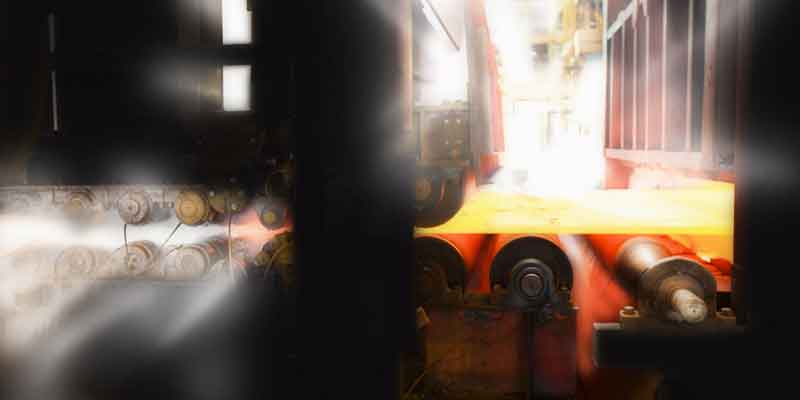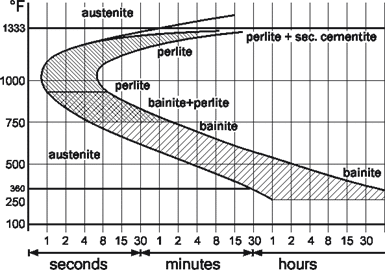
TTT Diagram
The time, temperature, transformation diagram (TTT) is the key guide for heat treating of steel. By using the diagram, a heat treat cycle can be developed that will provide the desired grain structure and properties required. The diagram is a function of temperature and time, showing the grain structure that will be formed based on how quickly the material is cooled or quenched. The slower the cooling process, the more austenitic grain structure will remain, providing a soft material with good ductility but lower strength. A very fast cool produces a total martensite grain structure, making a product high in strength but not ductile. The tempering process is an essential stage in heat treatment, especially in very fast cooling, as it brings back ductility.
Before we can start the quenching process we need to heat the steel to a high heat. We’re talking extreme here- over 1,600° F. Heating to this temperature causes a grain structure called austenite to form. An austenitic grain structure produces a very soft metal.

Quenching
After the metal is heated, we need to rapidly cool the steel. As material is quenched, the austenitic grain structure created during the heating stage transforms to different grain structures such as martensite, ferrite, pearlite, and cementite. The type of grain structure developed depends on how quickly the material is cooled.
There are a few different methods for cooling. Using a salt water solution is fastest and most severe, followed by fresh water, polymer, oil, and forced air is slowest. Fastest isn’t always best in this instance; sometimes quenching too quickly can cause cracking. Here at Clifton Steel, we use a fresh water quenching process.
Fresh Water Quenching
- Uniform cooling requires water maintained at a consistent temperature and evenly applied
- If the water gets too hot, desired grain structure won’t be obtained
- At Clifton, we have 2 heat-treat machines utilizing fresh water quenching
Polymer Quenching
- Water-based process
- Concentration of solution, operating temperature, and agitation need to be controlled to produce desired results
- Less severe than water or salt water quench
- Can accommodate interrupted quenching, meaning parts can be taken out before they are fully cooled. This can minimize the distortion without fire risk.
Oil Quenching
- Provides a slower cooling rate
- Used for alloyed steels, which could crack if a more severe method is used
- Reduces the amount of distortion created
- Selection of oil depends on geometry, thickness, and degree of distortion tolerance allowed
- Process can be much safer than it used to be by totally enclosing the operations
- Ability to recover and reuse about 80% of oil provides what some see as an advantage
- Largest obstacle for this technique is availability
Brining
- Not talking about a technique often used for a Thanksgiving turkey
- Also known as a salt quench, as is known to be a more severe quench
- Greatly reduces the steam jacket that usually forms with plain water quench. The steam blanket slows the quenching rate and hardness obtained in the steel
- Two types of salt: nitrate-based (most common) and chloride-based
- Gives you the ability to control quench severity through temperature, agitation, and water content.

Tempering
After being quenched, the metal is in a very hard state, but it’s brittle. The steel is tempered to reduce some of the hardness and increase ductility. It’s heated for a set period of time at a temperature that falls between 400° F and 1,105° F. Sometimes, if further ductility is needed, a higher temperature is used- around 1,300° F. Finally, the steel cools in still air rather than being quenched again.
The combination of these processes produces a steel with properties needed for the particular application. It’s ideal for use in military, machinery, mining, quarrying, earthmoving and construction industries. Often it is used for products that are exposed to high impact such as gear wheels, cutting edges, earthmoving buckets, dump truck wear liners, chutes, and more.
Contact a Clifton specialist if you have further questions about quenching and tempering and how it could impact your choice of products.